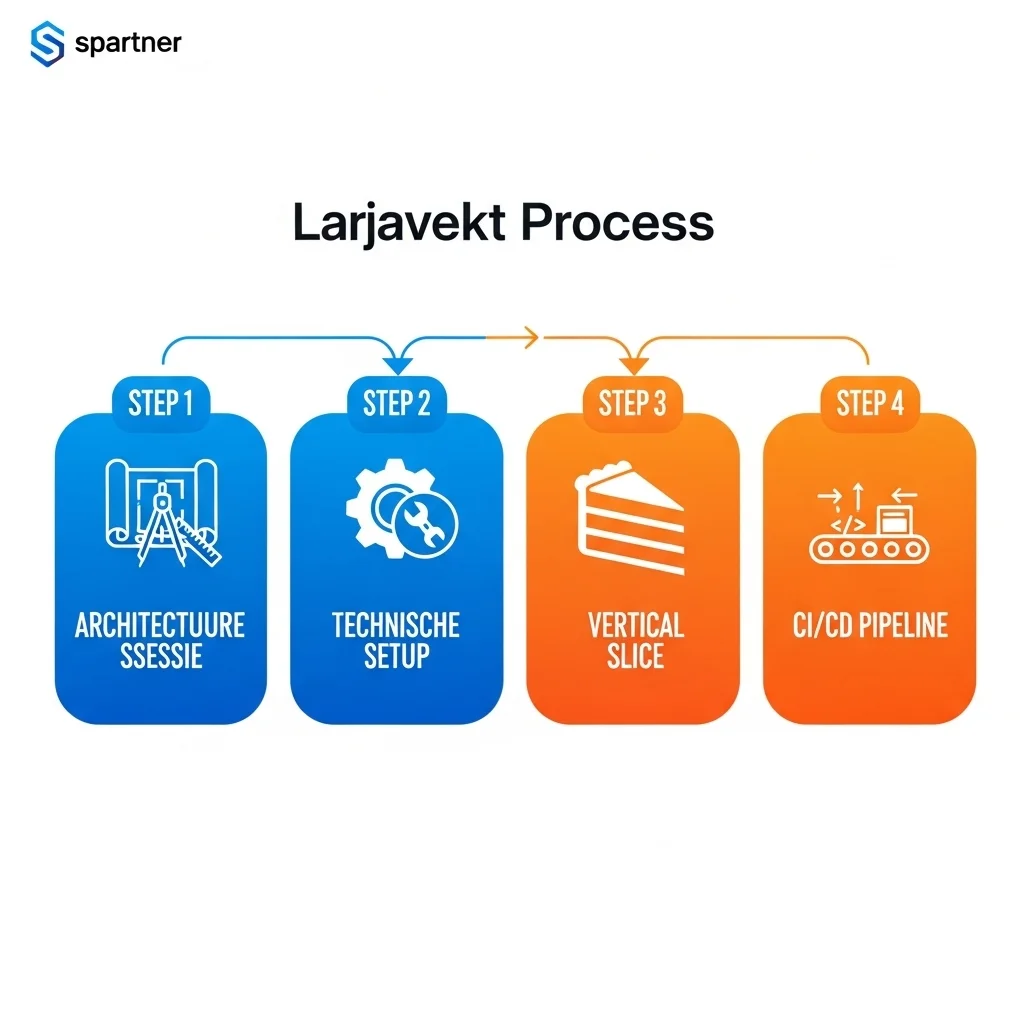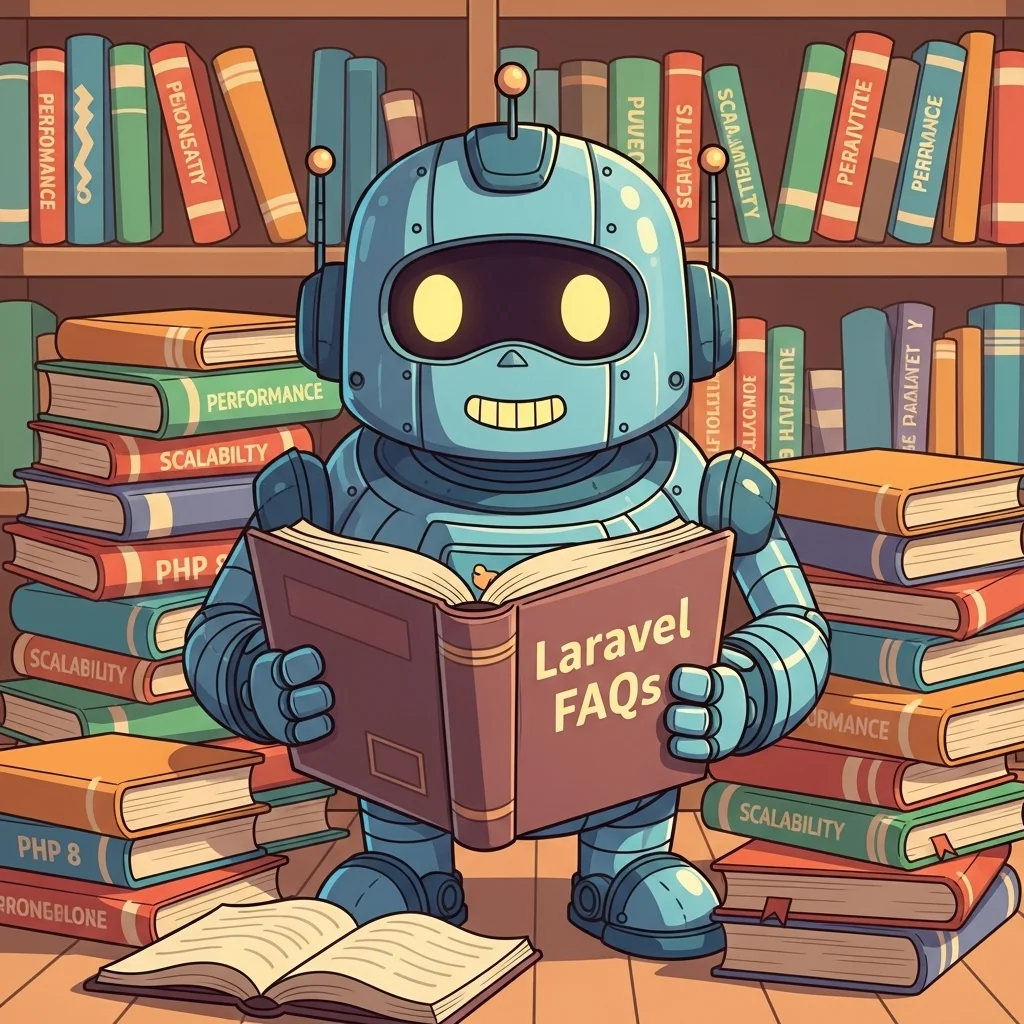Why do we, as an experienced development team, keep choosing Laravel time after time?
In a world overflowing with JavaScript frameworks and shiny new technologies, opting for a PHP framework might sound traditional. Yet it is a deliberate, strategic decision that lets us build robust, scalable and innovative software. Here is why.
Elegance in every line of code
Is Laravel the right choice?
It goes beyond syntax; it's a philosophy that drives business outcomes.
Developer happiness The tools and conventions of Laravel are designed to make developers both productive and happy. This translates directly into higher code quality and faster turnaround times. Less friction, more flow.
Robust ecosystem From authentication to job queues and from API development to server management, Laravel offers an integrated toolkit such as Forge, Vapor and Nova. We don't have to reinvent the wheel, which dramatically accelerates development.
Future-proof scalability Thanks to its modular architecture and focus on best practices, a Laravel application grows effortlessly alongside a company's ambitions—be it a complex e-commerce solution or a SaaS platform with thousands of users.
Security as a foundation Laravel ships with built-in protection against common vulnerabilities such as SQL injection and cross-site scripting (XSS). This “security by default” approach gives both us and our clients peace of mind, knowing the foundations are solid.

The art of omission: how Laravel makes us faster
In software development, what you don't have to build is often just as important as what you do.
Have you ever wondered why some projects get bogged down in complexity while others glide forward effortlessly? The answer often lies in the foundation: the framework you choose. For us, that foundation has been Laravel for years. And no, it's not out of habit; it's a choice rooted in a principle we embrace as a team: focus on what is unique.
Recently we sat down with a client who wanted to build a complex data-visualisation platform. The core of the application was unique, but everything around it—user management, permissions, API authentication, background jobs—was not. This is where Laravel's elegance shines. Within days we had a secure, working foundation. Users could log in, roles and permissions were managed, and the first API endpoints were protected. All thanks to Laravel's built-in components.
The "pit of success"
Taylor Otwell, the creator of Laravel, often talks about the "pit of success". The idea is simple: the framework should make it as easy as possible to do the right thing and hard to make mistakes. We see this in practice every single day.
Take Eloquent, Laravel's Object-Relational Mapper (ORM). It lets us talk to our database in a way that feels natural. Instead of writing complex SQL queries, we write readable, expressive PHP code. This not only prevents common mistakes (like SQL injection, against which Laravel protects you by default) but also makes the code much easier to maintain. A new developer can understand and work with the data models in a fraction of the time.
Another example is Blade, the templating engine. It's powerful yet simple. It doesn't force unnecessary logic into the view layer but gives us just enough tools to build reusable components and present data cleanly. The result? Faster load times and a cleaner separation between logic and presentation. These details might seem small, but together they save hundreds of development hours per project.
Interestingly, this focus on developer experience isn't an end in itself. Happy, productive developers write better code. They have the mental bandwidth to think about the client's complex, unique problems instead of wrestling with boilerplate. That's why we can fully focus on the business value we create for our clients.

What still fascinates me most about Laravel after all these years is how it grows with you. It started as an elegant MVC framework but has evolved into a complete ecosystem that supports every phase of the software lifecycle. It's a Swiss Army knife for the modern web developer.
From code to business value
A framework is more than a tool; it is a strategic partner in the growth of your business.
Technology choices are never purely technical. They have a direct impact on budgets, timelines and the ability to innovate. Laravel excels here because it bridges the gap between the technical world and business reality. It lets us talk not just about features but also about speed to market and total cost of ownership.
Start with the core: Use Laravel's built-in tools (Breeze, Jetstream) to set up fundamentals like authentication and user management straight away. Focus your energy on the unique features that make your application valuable.
Think in components: Build your front-end and back-end with reusable components. Blade components and modern tools like Livewire or Inertia.js make this easier than ever and keep your codebase maintainable.
Embrace the ecosystem: Make smart use of official packages like Laravel Nova for an admin panel or Laravel Forge for server management. This saves weeks of development and lets you benefit from the expertise of the world's best Laravel developers.
Invest in testing: Laravel's test suite is world-class. Write feature and unit tests from day one. It might feel slower initially, but it delivers a more stable and reliable product in the long run.
Our starting point for a new Laravel project
A solid start is half the battle. This is our tried-and-tested approach.
How do we kick off a new project at Spartner? It's a process we've refined over the years. It's not just `composer create-project`; it's about laying a foundation for long-term success.
Step 1: The architecture session
Before writing a single line of code, we sit down with the client and our team. What is the absolute core of the application? Which data flows exist? Do we expect high traffic peaks? At this stage we decide on things like:
Do we go for a classic monolith (server-rendered views) or an API back-end with a separate front-end? A monolith with Livewire or Inertia.js is often a sweet spot.
Which external services need integrating? Think payment providers, email services or CRM systems.
What will the database structure look like? We sketch the key models and their relationships. A good database structure is crucial for performance later on.
Pro-tip: Already at this stage, estimate the complexity of the permission structure. This is often an underestimated part.
Step 2: The technical setup and "boilerplate"
Now the real work begins. We set up the project—but we do it our way.
We initialise a Git repository with our standard branch strategy.
We install Laravel and configure the `.env` for different environments (local, staging, production).
We implement our standard toolset for code quality: PHPStan for static analysis and Pint for code styling. This keeps things consistent, no matter who works on the project.
We set up the authentication foundation with Laravel Breeze or Jetstream. This boilerplate gives us an immediate flying start.
Step 3: Building the first "vertical slice"
We don't work in layers (first the entire database, then the whole back-end, then the front-end). Instead, we build a vertical slice: one complete feature from start to finish—for example, adding a product to a catalogue.
We first write a feature test that describes the desired behaviour.
Next we create the migration for the database table.
Then the Eloquent model and the controller logic.
Finally the route and the Blade view.
This approach ensures we deliver value quickly and gather feedback immediately. It keeps the team motivated and the client engaged.
It keeps the team motivated and the client engaged.
Step 4: Continuous integration and deployment (CI/CD)
Automation is king. From day one we configure a CI/CD pipeline, often with GitHub Actions. Every time we push code, our tests run automatically, code quality is checked, and—if successful—the application is deployed to a staging environment. This reduces human error and makes the deployment process predictable and stress-free. We often use Laravel Forge, which integrates seamlessly with our workflow.

Beyond the hype: Laravel in a JavaScript world
How a PHP framework remains relevant—and even innovates—in today's tech landscape.
It's no secret: the tech world loves JavaScript. React, Vue, Svelte, Next.js—the list is endless and ever-changing. So why stick with a PHP framework? Because Laravel offers a unique and pragmatic answer to a common problem: the growing complexity of full-stack development.
A trend I'm watching closely is what I call the modern monolith. For years the fashion was to separate concerns strictly: a PHP/Laravel API as the back-end and a standalone JavaScript Single Page Application (SPA) as the front-end. However, that brings enormous complexity: two codebases, two build processes, two deployment pipelines and tricky state management.
The power of Livewire and Inertia.js
Livewire lets us build rich, dynamic interfaces with the simplicity and productivity of PHP and Blade. It feels almost magical: you write PHP classes and Blade templates, and Livewire handles the front-end communication, giving you an SPA-like experience without the SPA complexity.
Inertia.js is the perfect bridge for teams that want the power of React or Vue without the burden of a separate API. It lets you build a classic server-side application where the 'views' are JavaScript components. Client-side routing delivers a super-fast user experience.
What strikes me here is Laravel's philosophy: it embraces JavaScript's power but integrates it in a way that keeps developers productive. It solves the real problem: how do you build a modern, fast web application without drowning in complexity? For 9 out of 10 projects, a modern monolith with Laravel, Livewire or Inertia.js is the fastest, most cost-effective and most maintainable solution.
That doesn't mean we never choose a separate API. For mobile apps, or when a front-end truly needs to stand entirely apart from the back-end, Laravel as an API-only back-end is fantastic. Laravel Sanctum makes securing these APIs a breeze. But the beauty lies in the flexibility. Laravel doesn't lock you into one architecture—it gives you the tools to choose the right one for each specific project. And that, dear reader, is the essence of true expertise.

Frequently asked questions about Laravel development
Our answers to the questions we hear most often in practice.
1. Isn't PHP an outdated language?
Absolutely not. This is a stubborn misconception. Modern PHP (version 8 and above) is a fast, robust and mature language with features such as JIT compilation, a strong type system and asynchronous capabilities. Massive platforms like Facebook (Meta), Slack and Wikipedia run on PHP. Laravel brings out the best of modern PHP, making it an excellent choice for high-performance applications.
2. Can Laravel cope with large, complex applications?
Definitely. In fact, that's where it excels. Thanks to its modular design, the service container for dependency injection and built-in support for queues, Laravel can handle extremely complex systems. In our experience, application scalability is rarely limited by the framework; it's usually architecture, database design and server infrastructure. Laravel gives us the tools to design each of these elements correctly.
3. What about Laravel's performance?
Out of the box, performance is good—and with a few simple steps it can be excellent. Laravel provides commands to cache configuration, routes and views. By implementing an efficient caching strategy (for example with Redis) and optimising database queries, Laravel applications can handle millions of requests per day. Tools like Laravel Octane, which keep the application in memory, add an extra performance boost.
4. What is the biggest advantage of the Laravel ecosystem?
Consistency and quality. Because tools like Forge (server management), Vapor (serverless deployment), Nova (admin panel) and Spark (SaaS boilerplate) are all developed by the Laravel core team, they work together seamlessly. They follow the same design philosophy and coding standards. That's a huge advantage over cobbling together various third-party tools that may not be well-maintained or well-integrated.
5. Is it hard to find good Laravel developers?
On the contrary. Laravel is one of the most popular—if not the most popular—PHP frameworks in the world. The community is enormous, active and welcoming. There is an abundance of documentation, tutorials and online forums. This not only makes it easier to find talent but also ensures our own developers can continuously learn and grow. Laravel's popularity guarantees the future-proofing of that knowledge.
6. For which type of project is Laravel NOT the best choice?
Although Laravel is extremely versatile, there are scenarios where another tool may be a better fit. For a simple, static marketing site, a CMS like WordPress or a static site generator might be easier. For extremely high-frequency, real-time applications (such as an online game server), a language like Go or Elixir could be more suitable. But for 95% of the web applications, SaaS platforms, APIs and complex business software we build, Laravel is the sweet spot between productivity, performance and scalability.

Choosing a technology is a dialogue, not a dictate. Our passion for Laravel stems from years of experience building successful applications, but every challenge is unique.
Curious how Laravel's philosophy could accelerate your project? Or are you hitting the limits of your current setup? Let's exchange thoughts. No sales pitch, just an honest expert-to-expert conversation. Drop us a message and share your challenge—we'd love to hear your story.

